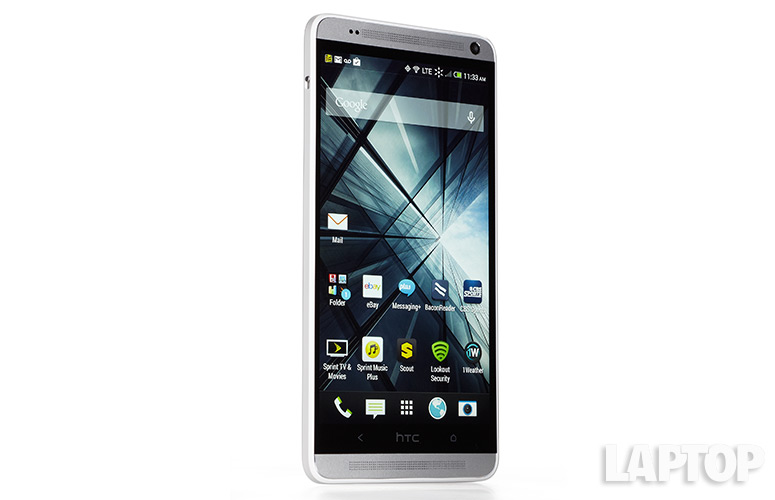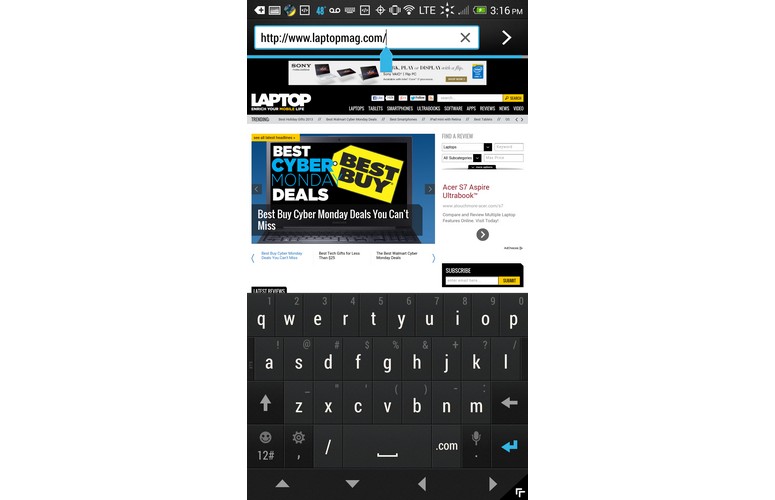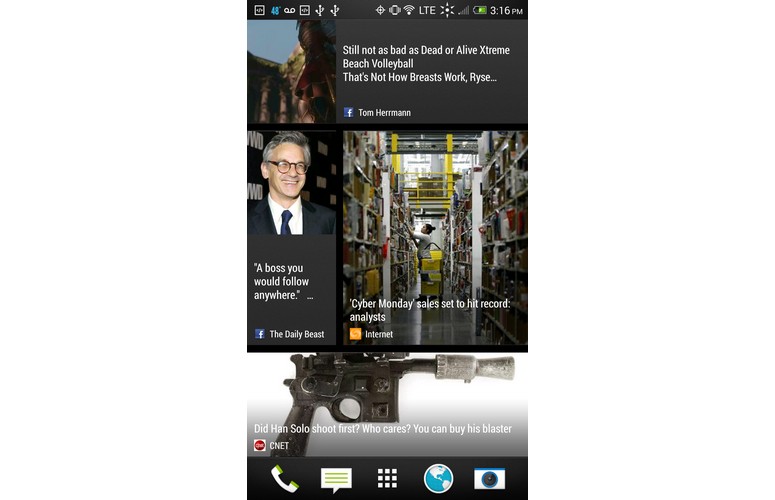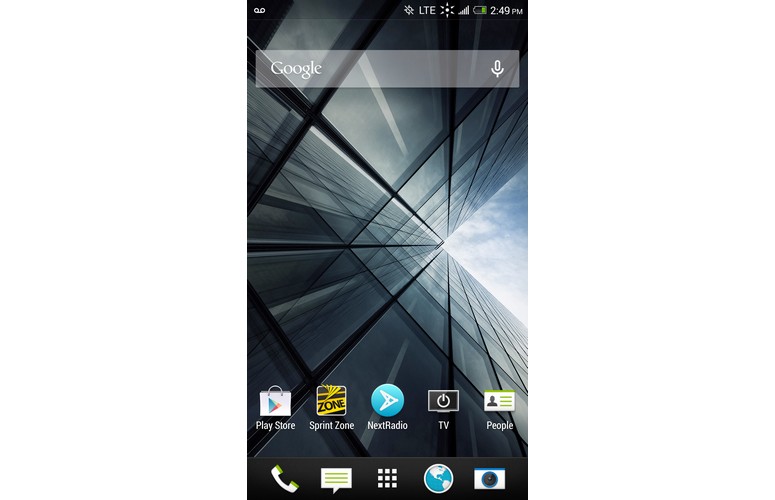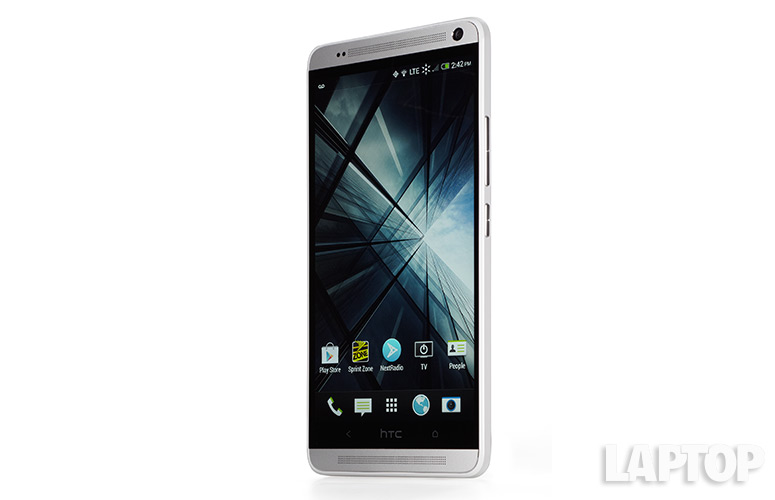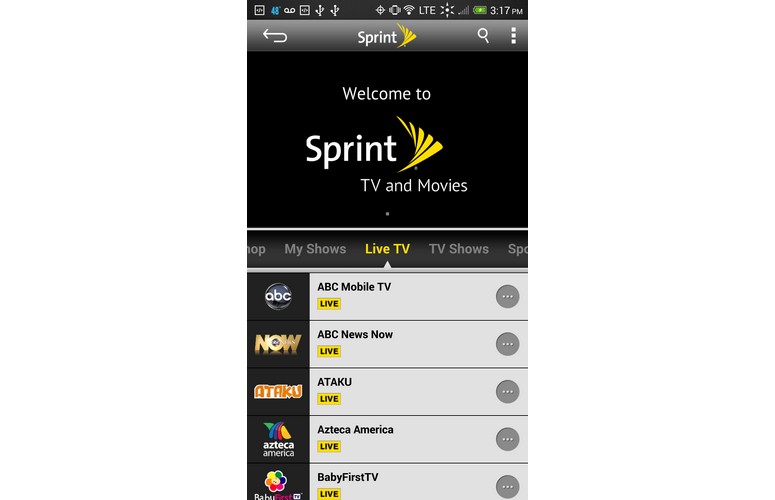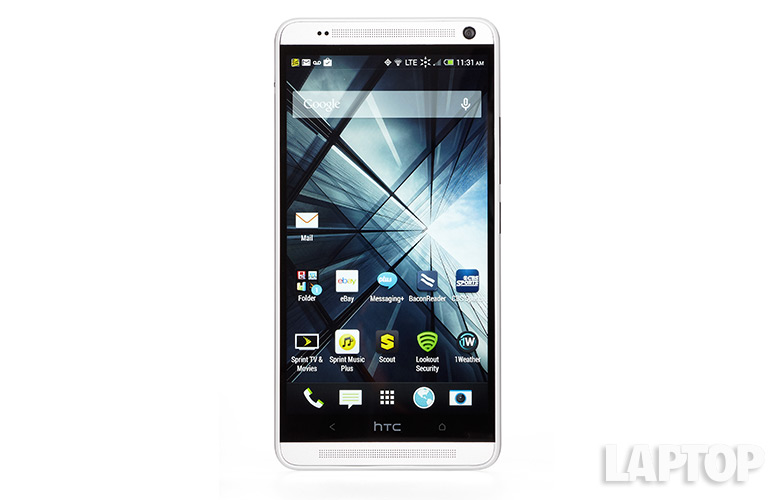Laptop Mag Verdict
The HTC One Max boasts a big and beautiful display, impressive battery life and fast Sprint Spark speeds, but it doesn't do enough to justify its girth.
Pros
- +
Beautiful 5.9-inch display
- +
Powerful BoomSound Speakers
- +
Fast performance
- +
Supports Sprint's faster Spark LTE network
- +
Fingerprint scanner
Cons
- -
Unwieldy and heavy design
- -
Software not optimized for larger screen
- -
Pricey
Why you can trust Laptop Mag
With its booming speakers and sleek aluminum design, the HTC One is one of the best smartphones yet. But what if you find its 4.7-inch display too small? Well, you could step up to the enormous 5.9-inch One Max, which has a bigger price to match. Available through Sprint for $249, the Max is essentially a supersized One, but HTC adds a fingerprint reader on the back. This is also one of the first smartphones to tap into the carrier's new high-speed 4G LTE Spark service. Is the massive One Max worth checking out?
Design
The HTC One Max looks like a regular One that spent the past few months shooting steroids with Jose Canseco. At 7.7 ounces, it easily outweighs most smartphones and phablets. And despite offering a smaller 5.9-inch screen than the 6.3-inch Samsung Galaxy Mega, the monolithic 6.5 x 3.2 x 0.41-inch One Max is nearly as big as the Samsung phablet (6.6 x 3.5 x 0.31 inches). In other words, good luck using this handset with one hand.
The Max is an amalgamation of the original One and the One Mini. It gets the same aluminum chassis as the regular One, and the same white polycarbonate edging found on the One Mini. And like all members of the One family, the Max comes equipped with HTC's dual, front-facing BoomSound speakers.
Below the One's 5.9-inch display is a pair of capacitive Android back and home buttons. Around back, you'll find the One's Ultrapixel camera and fingerprint scanner, which kind of seems like an afterthought compared to the iPhone 5s' Touch ID sensor. On the right edge are the phone's volume rocker and power button, which has been moved from the top of the handset to make it easier to reach.
On the left side is a slider lock that lets you remove the handset's rear panel to access its SIM card and microSD card slots. The One's bottom edge includes a microUSB port, while its top edge offers a 3.5mm headphone jack and IR blaster. (No, you can't replace the battery.)
Despite the One Max's large size, HTC does not include a stylus. Samsung's Galaxy Mega doesn't come with a pen, but its 5.7-inch Galaxy Note 3 does.
Sign up to receive The Snapshot, a free special dispatch from Laptop Mag, in your inbox.
Display
Click to EnlargeThe One Max offers a gargantuan 5.9-inch, 1920 x 1080-pixel Super LCD 3 display. With such a large screen, the One Max was purpose-built for surfing the Web, reading books and watching videos. Reading text on the Max's display was a dream, as letters were far larger than they would otherwise appear on the original 4.7-inch One. Photos and videos viewed on the One Max looked splendid.
A trailer for "X-Men: Days of Future Past" looked incredibly sharp, though the same was true on the Nokia Lumia 1520's 6-inch 1080p display. The Samsung Galaxy Mega's 720p display offered slightly less detail in certain scenes, especially close-ups of characters' faces. We also noticed that colors displayed on the Mega were far more exaggerated than those viewed on the One Max or the Lumia 1520.
The One's display is easily one of the brightest we've seen on a phablet, registering a sky-high 441 lux (410 nits) on our light meter. That's a huge advantage over the Lumia 1520 (328 lux). The Galaxy Mega was hot on the Max's heels, with a rating of 427 lux.
Audio
Click to EnlargeOne of the standout features of the One Max is its dual front-facing BoomSound speakers. Unfortunately, HTC has ended its partnership with Beats Audio, so unlike the One and the One Mini, the Max's speakers don't get the Beats treatment. Instead, the handset relies on HTC's own audio software.
That said, the One Max's speakers sounded spectacular. Bass hits from Pusha T's "Nosestalgia" landed with a thunderous pound, and guitar riffs from Every Time I Die's "INRIhab" ripped through the low din of our newsroom with piercing clarity.
Keyboard
Click to EnlargeThe One Max gets the same custom HTC Android keyboard as the One and One Mini. The keyboard offers trace typing, autocorrect and next-word prediction. We just wish HTC included a one-handed virtual floating keyboard, similar to what Samsung offers on the Mega. You'll have to type with two hands.
Interface
Click to EnlargeRunning on Android 4.3 with HTC's Sense 5.5 overlay, the One Max offers a nearly identical interface to what's found on the HTC One. The handset's most prominent feature is its BlinkFeed home screen. The app offers a steady stream of updates from various sources, including social media sites and news organizations, arranging them in a Windows Phone-like tiled format.
Via the BlinkFeed Setup Wizard, you can choose from a host of sources, ranging from the Associated Press and the Huffington Post to Jalopnik and ESPN. HTC allows you to browse various categories, such as Business, Technology, Politics and others. Social media options include Facebook, Twitter and LinkedIn.
With Sense 5.5, HTC made it easier to navigate BlinkFeed's various categories. Users can now simply swipe in from the left side of the screen to open the app's settings menu, rather than having to scroll to the top of the screen. Just above these news updates, HTC displays a large clock, the date, your next appointment and the weather.
MORE: 12 Surprising Things Your Android Phone Can Do
If BlinkFeed is too busy for you, HTC offers the option of using it as a secondary home screen and adding a more traditional layout instead. Across the bottom of the regular home screen, you'll find the standard Phone, Message, Apps Menu, Browser and Camera buttons. Above these options are shortcuts to the Google Play store and Sprint's folder of apps.
Click to EnlargeThe HTC One Max's app menu has a far cleaner look than most Android phones and offers the option to change the layout's grid size. This means you can view apps in either a 3 x 4 or a 4 x 5 layout. You can also choose to sort apps in alphabetical order or by most recent. The top of the app screen includes shortcuts for the Google Play store, Search and Settings.
The Max's notification drawer is fairly basic when compared to that of the Samsung Galaxy S4 -- in fact, too basic. You can toggle the One's Power Saver function and Settings shortcut, whereas the S4's notification drawer lets you adjust an array of features, such as Display Brightness, Wi-Fi, Bluetooth, Screen Rotate and Multi Window Mode.
Fingerprint Reader
Click to EnlargeAside from its bigger screen, the only major difference between the One and One Max is the inclusion of a fingerprint reader. Situated on the Max's rear panel, the reader enables users to unlock the handset without having to trace an on-screen pattern or enter a PIN. Users can save up to three different fingerprints to the scanner and assign each one a specific app that will automatically launch when you swipe a certain finger.
Setting up the app takes just seconds. Once you open it, you'll be prompted to select the finger you want to save, swipe it four times across the scanner and choose the app you want to associate with the fingerprint. That's it. You can also delete saved fingerprints if you'd like to change the apps they launch. While this scanner worked well, we found reaching around the device a pain compared with the front-mounted Touch ID home button on the iPhone 5s.
Performance
Click to EnlargeThe One Max has a bigger display than the original One, but it still includes the same quad-core Snapdragon 600 processor and 2GB of RAM as its smaller sibling. That's not to say the One Max is a slowpoke. On the contrary: This handset is exceedingly fast. The handset took just 1.6 seconds to launch the camera app. That's on a par with the Snapdragon 800-powered Nokia Lumia 1520 and a hair faster than the 2.2 seconds it took Samsung's dual-core Snapdragon S4 Pro-powered Galaxy Mega to launch its camera app. Each handset fired off shots in less than a second.
It took the HTC One Max just 16 seconds to load the game "N.O.V.A. 3." That's 1 second slower than the Galaxy Mega and smartphone category average. The Galaxy Note 3, which has a faster Snapdragon 800 CPU, took 13 seconds.
On our video transcode test, it took the One Max 7 minutes and 33 seconds to transcode a 204MB, 1080p video to 480p using the VidTrim app. The average smartphone takes nearly a minute longer (8:20). The Mega took even longer, wrapping up in 9:15, but the Note 3 needed only 5:15.
The One Max performed well on various benchmarks but continued to trail the Note 3. On the Quadrant test, which measures a device's overall performance, the Max came in with a score of 11,981, well above the smartphone category average of 7,384. However, the Note 3 nearly doubled up the Max, with a score of 22,383.
On the GeekBench 3 test, which measures overall performance, the One Max notched 1,902. That absolutely blows away the Samsung Galaxy Mega's score of 1,098, as well as the category average of 1,580. The Note 3 scored 2,979. (Are you sensing a pattern?)
Graphically, the One Max has some chops. On the 3DMark Ice Storm Unlimited test, the phablet reached 10,984, which is better than the category average (9,583) but once again not in the same league as the Note 3 (18,808).
The One Max comes with 32GB of onboard storage. Unlike the original One or the One Mini, the One Max comes with a microSD card slot behind its removable rear panel.
Camera and Camcorder
Click to EnlargeThe One Max gets the same Ultrapixel rear camera found on the HTC One and One Mini. HTC says the shooter's f/2.0 aperture lens is capable of capturing 300 percent more light to help it take better low-light photos. As expected, the One Max captured beautiful images, especially in dim conditions.
A photo of a busy intersection looked alive with color, though we were surprised to see that images were a bit blurry when viewed at full size. The Galaxy Mega's 8-MP camera was the polar opposite, with plenty of details visible and colors appearing too dark. The Nokia Lumia 1520's 20-MP camera produced the best images of the three phablets, with splendid colors and an impeccable level of detail.
A 1080p video taken with the One Max offered saturated colors that made details a bit hard to see. We preferred videos taken with the Lumia 1520, as they were cleaner than those taken with the Max.
[sc:video id="g3bHE1cTqdT2PhWKM6aWRh9YsCuiw40o" width="575" height="398"]
The One Max's 2.1-MP front camera captured relatively clean images, though shots had a slightly red hue.
Apps
Click to EnlargeIn addition to standard Android apps -- including YouTube, Gmail and the Play store -- the One Max comes with a host of Sprint-specific apps. The Sprint Zone app is your one-stop shop for your Sprint account information, while Sprint TV and Movies serves as the carrier's entertainment app. (Skip the latter.)
Sprint Music Plus is, as its name implies, Sprint's own music service. Want to listen to music, but don't want to use your data connection? The Next Radio app provides access to FM radio stations across the country. You'll have to connect your headphones to your phone, however, as they serve as the antenna.
One of the marquee apps provided with the One Max is Zoodles. The kid-friendly app lets parents set app restrictions for their children, provides age-appropriate games, and offers a host of fun features, including art studio and video messaging to trusted friends and relatives.
Sprint Spark
Click to EnlargeThe One Max is one of the first handsets to ride on Sprint's new tri-band enhanced LTE network, otherwise known as Spark. Sprint claims the network, which is still in its infancy, will eventually offer speeds as high as 60 Mbps; a 60-minute HD movie will take just 2.5 minutes to download. Launch cities for Spark include Chicago, Los Angeles, Miami, Tampa and our home base, New York.
As the network is just getting off the ground, our testing required that we visit two specific spots in the Big Apple: the intersection of 63rd Street and Lexington Avenue, and the corner of 56th Street and Lexington Avenue. A third location -- 47th Street between 5th and 6th Avenues -- is also available. Move beyond those spots, however, and you'll lose your connection to Spark. You know you're connected to the Spark network if you see the six-point sun icon that appears next to the LTE logo in your handset's notification bar.
We took the HTC One Max and Samsung's Galaxy Note 3 (riding on Sprint's standard LTE network) to the aforementioned locations and were unsurprised by the results. The Spark-enabled HTC One Max saw average download speeds of 26.7 Mbps and average uploads of 17.5 Mbps at the 63rd Street and 56th Street locations.
The Note 3 was only about half as fast at both locations, with downloads averaging 10.3 Mbps and uploads averaging 6.41 Mbps.
The HTC was faster when surfing the Web, but not by much. The Max loaded the NYTimes.com mobile site in 3.2 seconds and Laptopmag.com in 6.4 seconds, while the Note 3 took 4.3 seconds and 6.6 seconds, respectively.
As expected, the One Max also had a large advantage over the Note 3 when downloading large files. The Spark-enabled HTC took 1:44 to download a 200MB trailer, versus 4:41 for the Note 3.
It's worth noting that there are few Spark-enabled phones available and that the network had few, if any, other people on it during our testing. As the network load increases, we would expect throughput to drop.
Battery Life
Click to EnlargeHTC gave the One Max a massive 3,300 mAh lithium polymer power plant. With such a large battery, the Max lasted an impressive 8 hours and 32 minutes on our LAPTOP Battery Test, which involves continuous Web surfing over Sprint's LTE network with the display brightness set to 40 percent. The Galaxy Note 3, however, lasted nearly 10 hours on Verizon's network. The Samsung Galaxy Mega, with its 3,200 mAh battery, lasted 7:13. The smartphone average is 6:36.
MORE: 10 Smartphones with the Longest Battery Life
Anecdotally, when testing the Max on Sprint's Spark network, we noted that the handset's battery life dropped quite quickly. The battery meter dropped by 10 percent in 30 minutes.
Verdict
Click to EnlargeThe HTC One Max is a gorgeous Android device that offers a beautiful 5.9-inch display, powerful speakers and a premium chassis. And, unlike the Galaxy Note 3, this $249 handset delivers faster LTE data via Sprint's Spark network. However, the Max's monstrous dimensions and heft will likely prove too much to handle for most users. The addition of a microSD card slot is welcome, but the fingerprint sensor doesn't add that much value.
Overall, the Galaxy Note 3 ($349 on Sprint, $199 on Verizon, $249 on AT&T and $0 down on T-Mobile) does more with its larger display, including pen input and Multi View split-screen multitasking. It also boasts a faster Snapdragon 800 CPU and longer battery life. The One Max is essentially a bigger One with similar specs, making it a good phablet purchase only for those who crave HTC's design and sound.
- Top 10 Smartphones
- Best & Worst Smartphone Brands 2013
- Smartphone Buyers' Guide 2013: 7 Things You Need to Know
HTC One Max (Sprint) Specs
| Alternate Carriers | Unlocked, Sprint |
| Bluetooth Type | Bluetooth 4.0 |
| Brand | HTC |
| CPU | 1.7-GHz quad-core Qualcomm Snapdragon 600 processor |
| Camera Resolution | 4 MP |
| Carrier | Sprint |
| Company Website | www.htc.com |
| Data | CDMA, LTE, HSDPA/UMTS, GSM/GPRS/EDGE |
| Display (main) | 5.9-inch 1920 x 1080 Super LCD 3 |
| Display Resolution | 1920x1080 |
| Form Factor | Candybar Touchscreen |
| Front Camera Resolution | 2.1MP |
| GPS | Yes |
| Internal Memory | 32GB |
| Memory Expansion Type | microSD Card |
| Networks | Sprint: 1900/2100 MHz with HSPA+ up to 14.4 Mbps |
| OS Family | Android |
| Operating System | Android 4.3 |
| Phone Display Size | 5.9 |
| Ports | microUSB, microSIM, microSD, 3.5mm headphone |
| RAM | 2GB |
| Size | 6.5 x 3.2 x 0.41 |
| Talk / Standby Time | 25 hours on 3G/ 585 hours on 3G |
| Weight | 7.7 ounces |
| Wi-Fi | 802.11a/ac/b/g/n |

